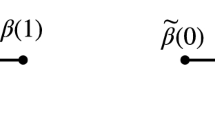Abstract
In this paper, we study normal forms of plane curves and knots. We investigate the Euler functional E (the integral of the square of the curvature along the given curve) for closed plane curves, and introduce a closely related functional A, defined for polygonal curves in the plane ℝ2 and its modified version A R , defined for polygonal knots in Euclidean space ℝ3. For closed plane curves, we find the critical points of E and, among them, distinguish the minima of E, which give us the normal forms of plane curves. The minimization of the functional A for plane curves, implemented in a computer animation, gives a very visual approximation of the process of gradient descent along the Euler functional E and, thereby, illustrates the homotopy in the proof of the classical Whitney-Graustein theorem. In ℝ3, the minimization of A R (implemented in a 3D animation) shows how classical knots (or more precisely thin knotted solid tori, which model resilient closed wire curves in space) are isotoped to normal forms.
Similar content being viewed by others
References
S. Avvakumov, software available at http://www.mccme.ru/knotenergy.
R. Bryant and P. Griffits, “Reduction for Constrained Variational Problems and Σκ 2 ds,” Amer. J. Math. 108(3), 525–570 (1986).
L. Euler, Methodus inveniendi lineas cyrvas maximi minimive proprietate gaudentes, sive Solutio problematis isoperimitrici latissimo sensu accepti (Lausanne, Genève, 1744).
M. H. Freedman, Z.-X. He, and Z. Wang, “Möbius Energy of Knots and Unknots,” Ann. of Math. (2) 139(1), 1–50 (1994).
O. Karpenkov, “Energy of a Knot: Variational Principles,” Russ. J. Math. Phys. 9(3), 275–287 (2002).
O. Karpenkov and A. Sossinsky, “Energies of Knot Diagrams,” Russ. J. Math. Phys. 18(3), 306–317 (2011).
D. Kim and R. Kusner, “Torus Knots Extremizing the Möbius Energy,” Exper. Math. 2(1), 1–9 (1993).
J. Langer, D. Singer, “The Total Squared Curvature of Closed Curves,” J. Diff. Geometry 20(1), 1–22 (1984).
J. Langer, D. Singer, “Knotted Elastic Curves in R 3,” J. London Math. Soc. 30(2), 512–520 (1984).
R. Levien, The Elastica: a Mathematical History, EECS Department, University of California, Berkeley, Technical Report No. UCB/EECS-2008-103, 2008, http://www.eecs.berkeley.edu/Pubs/TechRpts/2008/EECS-2008-103.html.
J. O’Hara, “Energy of Knots and Conformal Geometry,” K & E Series on Knots and Everything, World Scientific 33, 288 (2003).
S. Yu. Orevkov, “Physical Proof of the Whitney Theorem about Plane Curves,” Math. Prosveshenie, Ser.2, (3), 96–102 (1984).
Yu. S. Osipov, M. I. Zelikin, “Higher-Order Euler Elastics and Elastic Hulls,” Russ. J. Math. Phys. 19(2), 163–172 (2012).
Yu. L. Sachkov, “Closed Euler Elasticae,” Proc. Steklov Inst. Math. 278, 218–232 (2012).
A. B. Sossinsky, “Mechanical Normal Forms of Knots and Flat Knots,” Russ. J. Math. Phys. 18(2), (2011).
A. B. Sossinsky, “Normal Forms of Twisted Wire Knots,” Russ. J. Math. Phys. 19(3), (2012).
R. Sridharan, “Physics to Mathematics: from Lintearia to Lemniscate — I,” Resonance, 21–29 (2004).
Author information
Authors and Affiliations
Corresponding author
Rights and permissions
About this article
Cite this article
Avvakumov, S., Karpenkov, O. & Sossinsky, A. Euler elasticae in the plane and the Whitney-Graustein theorem. Russ. J. Math. Phys. 20, 257–267 (2013). https://doi.org/10.1134/S1061920813030011
Received:
Revised:
Published:
Issue Date:
DOI: https://doi.org/10.1134/S1061920813030011



